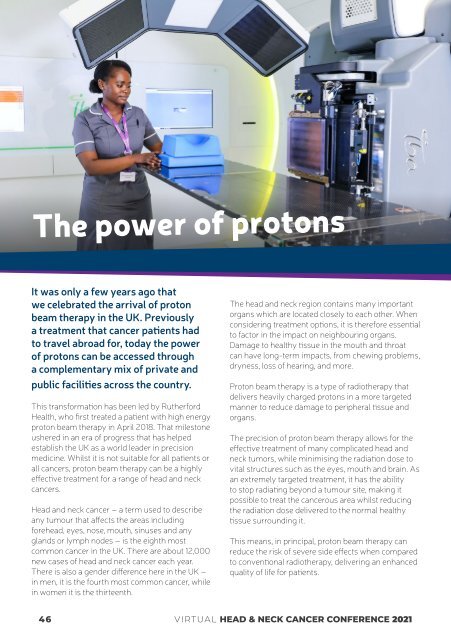2021 Head & Neck Cancer Conference
You also want an ePaper? Increase the reach of your titles
YUMPU automatically turns print PDFs into web optimized ePapers that Google loves.
The power of protons<br />
It was only a few years ago that<br />
we celebrated the arrival of proton<br />
beam therapy in the UK. Previously<br />
a treatment that cancer patients had<br />
to travel abroad for, today the power<br />
of protons can be accessed through<br />
a complementary mix of private and<br />
public facilities across the country.<br />
This transformation has been led by Rutherford<br />
Health, who first treated a patient with high energy<br />
proton beam therapy in April 2018. That milestone<br />
ushered in an era of progress that has helped<br />
establish the UK as a world leader in precision<br />
medicine. Whilst it is not suitable for all patients or<br />
all cancers, proton beam therapy can be a highly<br />
effective treatment for a range of head and neck<br />
cancers.<br />
<strong>Head</strong> and neck cancer – a term used to describe<br />
any tumour that affects the areas including<br />
forehead, eyes, nose, mouth, sinuses and any<br />
glands or lymph nodes – is the eighth most<br />
common cancer in the UK. There are about 12,000<br />
new cases of head and neck cancer each year.<br />
There is also a gender difference here in the UK –<br />
in men, it is the fourth most common cancer, while<br />
in women it is the thirteenth.<br />
The head and neck region contains many important<br />
organs which are located closely to each other. When<br />
considering treatment options, it is therefore essential<br />
to factor in the impact on neighbouring organs.<br />
Damage to healthy tissue in the mouth and throat<br />
can have long-term impacts, from chewing problems,<br />
dryness, loss of hearing, and more.<br />
Proton beam therapy is a type of radiotherapy that<br />
delivers heavily charged protons in a more targeted<br />
manner to reduce damage to peripheral tissue and<br />
organs.<br />
The precision of proton beam therapy allows for the<br />
effective treatment of many complicated head and<br />
neck tumors, while minimising the radiation dose to<br />
vital structures such as the eyes, mouth and brain. As<br />
an extremely targeted treatment, it has the ability<br />
to stop radiating beyond a tumour site, making it<br />
possible to treat the cancerous area whilst reducing<br />
the radiation dose delivered to the normal healthy<br />
tissue surrounding it.<br />
This means, in principal, proton beam therapy can<br />
reduce the risk of severe side effects when compared<br />
to conventional radiotherapy, delivering an enhanced<br />
quality of life for patients.<br />
46<br />
VIRTUAL HEAD & NECK CANCER CONFERENCE <strong>2021</strong>
















